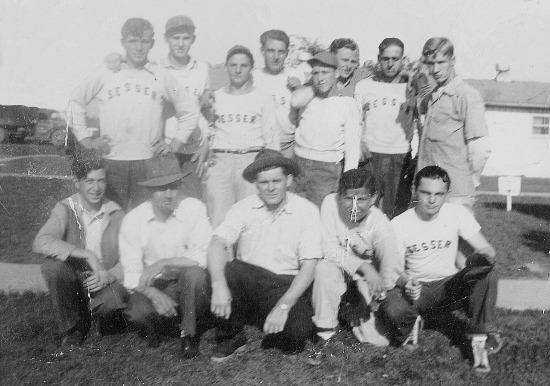
Gary W. Moore had lots of dots to connect about his father’s life. The problem was that, for many years, Gene Moore refused to talk about them.
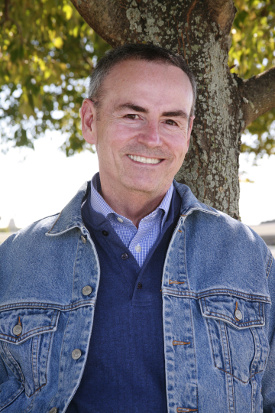
Gary Moore will be participating in a handful of local events related to his 2006 book Playing with the Enemy as part of the Scott County Reads Together program April 12 through 15, and you can get a sense of the connections from the hardcover’s subtitle: A Baseball Prodigy, a World at War, & a Field of Broken Dreams.
Gene’s story itself is fantastic, but so is the tale of the book’s becoming – with a curious son and a reticent father, and with tantalizing bits of information finally put together into a narrative that’s both heartwarming and heartbreaking.
There was, for example, the January 1949 letter to Gene from the Pittsburgh Pirates minor-league baseball system, promising to “give you every chance and our ablest assistance in making a capable ball player.”
Gary Moore found the letter when he was 12, and it aligned with other things he’d heard.
He remembers visiting his father’s hometown of Sesser, Illinois, when he was seven or eight, and a man stuck his head out of the bar and asked if he was Gene’s kid. A group of older men pulled him into the bar and talked to him about his dad.
In a phone interview last week, Gary Moore recalled telling his father: “They said you were the greatest baseball player to ever play” in Sesser. He continued: “My dad kind of laughed and shrugged and he said, ‘This town has 700 people in it. If you’re the best baseball player in the town, that really doesn’t mean much.’”
When Moore was about 16, an older cousin was talking to him about baseball uniforms. “He said, ‘When your dad came home from his first season with the Dodgers, he gave me his jersey. I wore that damn thing until it just fell apart.’ I looked at him and I said, ‘My dad never played baseball for the Dodgers.’ And he said, ‘Go home and ask him.’ I went home and asked my dad and he just kind of shrugged and said, ‘Don’t pay attention to him.’”
Moore said that as he got older, he was increasingly unwilling to accept those dismissals. But his father was equally stubborn. As a teenager, Moore said, he demanded: “‘Tell me about that letter you got from the Pirates.’ And he said, ‘I told you never to ask me about that again.’ And that was it; he just shut down.”
That’s one set of dots. Gary Moore knew his father was a good baseball player who’d gotten a look from at least two major-league baseball organizations.
The other dots are smudgy. There was a visit to the Moore home by a German man in 1959 – when Gary Moore wasn’t yet five. “I don’t remember any details other than ... my sister and I hiding behind a chair and giggling,” he recalled. “I think I was laughing at his language; he talked different than anybody I’d ever heard before.”
And a trip to Chicago’s Museum of Science & Industry in the early 1960s to see the Nazi U-505 submarine. Moore said he remembers watching a film of the prisoners from the ship, with closeups of each in a single-file line. “One of the sailors looks at the camera, and he kinda smiles. I’m sure it was a nervous smile. I’m sure he wasn’t having a good time that day; he’d just been captured. And my dad started crying.” Gene Moore said he had something in his eye.
“I knew there something about that submarine, and something about something,” Gary Moore said. “I’d ask my mother about it through the years, and she would just always say, ‘You really need to talk to your father about that.’ My father wasn’t talking.”
In high school, Gary got an assignment to write about his mother. He decided to also, on his own, write a piece about his father. “When I wrote it about my mother, I just wrote it,” he said. “When I wrote about my father, I realized: I don’t even know what to write; I don’t really know who this man is. I knew he fed us and clothed us, and I know he was a hard worker. I think he was an honest guy, ... but I really didn’t know anything about him.”
Once again, his father was no help, saying: “When people remember me, I hope they say, ‘He was a good husband [and] a good father, and he worked hard.’ That’s all there is about me.”
Gary knew that wasn’t true.
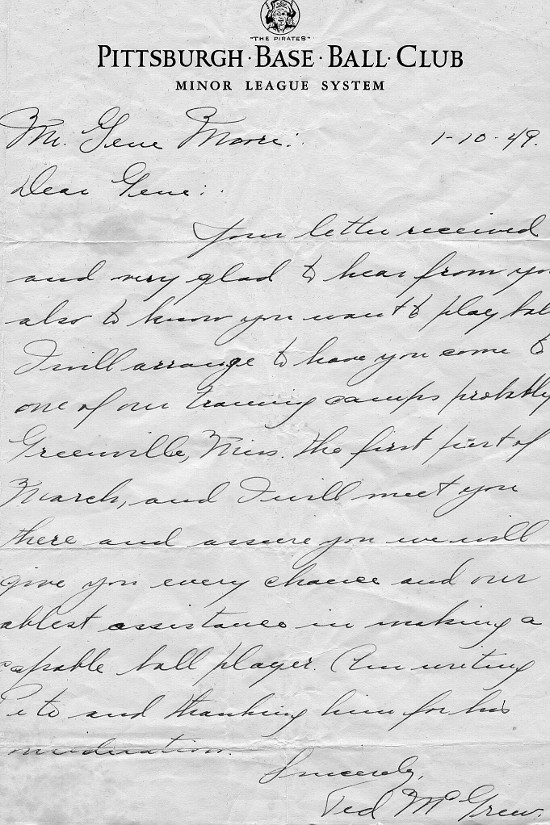
“The Dike Had Broken”
In April 1983, Gene Moore had a health scare. On May 12, a heart specialist gave him a clean bill of health and said it hadn’t been a heart attack.

Gary and Gene left the doctor’s office and went out to dinner. Gene was in good spirits, and 28-year-old Gary decided to press his 57-year-old father about his life in baseball.
“What changed in that restaurant is he had this incredible sense of relief, he was relaxed, we were sitting there alone, I started trying to talk to him, he started getting angry, and for the first time in his son’s life, his son stood up to his dad,” Gary said. “I said, ‘I’m not leaving here without you answering these questions.’”
Gene still pushed back, but Gary didn’t relent. “My dad was crazy about his grandkids. ... I said to him, ‘Toby’s five years old; he loves you. Someday he’s going to want to know about his grandfather. He’s going to ask me, and I’m not going to be able to tell him a damn thing. I want my son to know you, and I need to know you.’ ...
“You could tell the first five, six minutes of that conversation were painful. Then all of a sudden it was like the dike had broken. I couldn’t have shut him up if I wanted to.”
Gene died the next day of a heart attack.
“I’d always thought this would be a story I’d write,” Gary said of the tale he heard that night at dinner. “Early on, I knew it was an incredible story, an incredible life. Sad in so many ways, but also very uplifting in others.”
Yet more than two decades passed before Gary began writing. “It took time to digest my dad’s life,” he said, and “to understand the potential impact on other people. ... I’m sorry I waited so long, but I think had I done it 10 years ago, 15 years ago, 20 years ago, it would have been a much different book, because I don’t think I totally understood.”
Without giving too much away, Gene was a power-hitting catcher who, at age 15 and playing for the semi-pro Sesser Egyptians, attracted the attention of Brooklyn Dodgers scout Frank Boudreau in 1940. His World War II service had him playing for the Navy team, and eventually teaching captured U-505 sailors to play baseball in a secret POW camp in Louisiana. After the war, Gene got another shot in the minors, but an injury cut short his career ... with the saving grace of the hobbled catcher helping a friend and teammate get to the majors.
It’s undeniably a great story. But when Gary Moore, at the urging of a friend, finally got around to writing it, there were lots of challenges.
Gary W. Moore had lots of dots to connect about his father’s life. The problem was that, for many years, Gene Moore refused to talk about them.
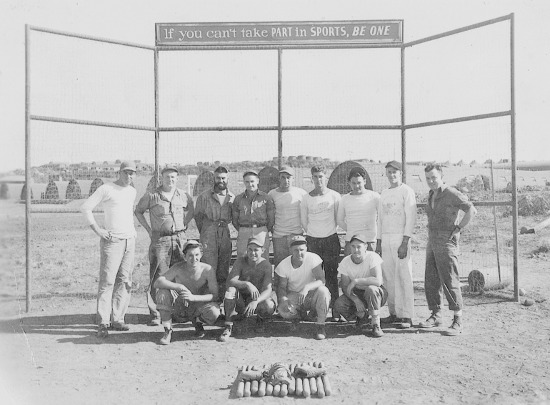
“The Story Was Incomplete”
For one thing, Gary’s conversation with his father had taken place 20-odd years earlier, and he hadn’t taken notes or recorded it. Many of the participants, like his father, were dead.
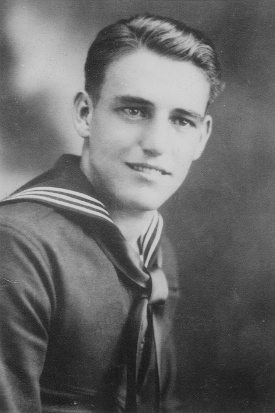
And the historical record is sparse. Much information about the Louisiana POW camp remains classified, and rosters and stats for minor-league baseball in the middle of the 20th Century are spotty. Some readers of Playing with the Enemy have questioned the veracity of the entire story, noting that there’s no record of a Pirates minor-league team in Greenville, Mississippi, in the late 1940s. (The 1949 letter from the Pirates clearly says Greenville, Mississippi, and Gary Moore said he verified the team’s existence with the city’s historical society; it was one of many short-lived clubs set up to handle the flood of war veterans coming back into baseball.)
Moore stressed that the book is not a biography; it’s historical fiction inspired by true events, with roughly half the names made up. “It’s the best we could do, because my father isn’t a historical figure,” he said. “He didn’t make it into the major leagues. And it’s all pre-Internet. There’s just not much of a record of his life. ...
“Most of the story is oral histories. Some of it [was] what I remember from my dad’s conversation. But most of it came from talking to relatives ... .” Moore said he had assistance from the Dodgers and the Navy, and he got lots of information from lifelong residents of Sesser, whom he gathered for a dinner at a local restaurant to reminisce.
“But the story was incomplete,” Moore said. “I have done a lot of connecting of the dots here that I could’ve gotten wrong. I’ve re-created conversations that I didn’t have access to. ... I put it together as best I could. ... I never witnessed any of it. But I’m confident, where the record fails us, [that] I got the spirit of my father’s life correct.”
Initially, Moore thought that one key figure in the book – a man he calls Ray Laws – was All-Star pitcher Roy Face. Gary remembers watching, as an adolescent, Face warmly greet Gene at a Cubs game.
But he could never find evidence that Face and his father played on the same baseball team; to the best of his knowledge, Gene’s minor-league career ended before Face’s began. It’s only been since the book was initially published 10 years ago that he discovered his father played another year of ball after the core story of Playing with the Enemy finishes.
And over the years, other blanks have been filled in by readers who knew or knew of Gary’s dad. “It’s almost like a living, breathing story that continues to evolve,” Moore said.
The author concedes that, in the grand scheme of history, Gene’s story “has no historical importance to anybody. It doesn’t change anything. It’s a history of my father’s life.”
But that history – one that easily could have died with Gene Moore – has survived and taken on a life of its own.
Before the book was published – on his daughter’s wedding day, in fact – Gary got a praising letter from President George W. Bush, who’d somehow read a galley copy. Moore has gotten an e-mail from Al Pacino.
“I have received ... somewhere between 3,000 and 4,000 letters ... from all over the world, from people who have said ... that my father’s story had uplifted them, encouraged them, helped them change their life,” Moore said. “It’s bizarre, some of the things. A little boy in Calgary, Canada, playing on a little-league baseball team up there and had terminal cancer. And said he was dedicating his last game that he thought he’d be able to play to my father. A veteran who recently died, a 92-year-old man in Poughkeepsie, New York, who died reading my book, and his granddaughter wrote me and told me he’d read it 10, 20, 30 times and his only wish ... was that he be buried with the book. ...
“The book has sprouted legs, and it’s gone places I never would have dreamed.”
Gary W. Moore will be featured in nine events from April 12 through 15 as part of the Scott County Reads Together project. For a full listing of events, visit RCReader.com/y/moore.
For more information on Gary W. Moore, visit GaryWMoore.com.










